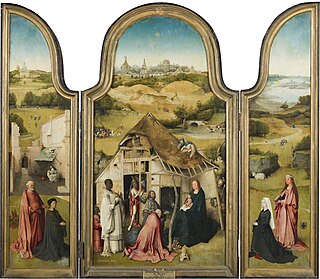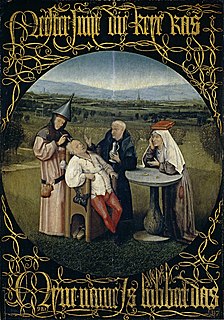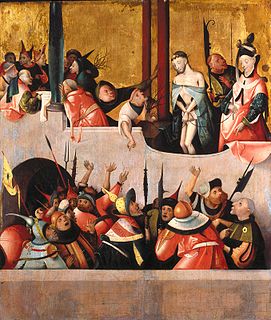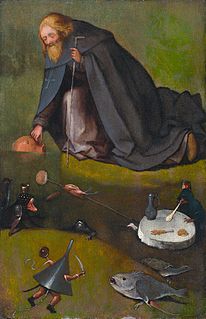 W
WAdoration of the Christ Child is a painting previously attributed to Hieronymus Bosch portraying Mary and the Christ Child. It is in the Wallraf-Richartz Museum in Cologne.
 W
WThe Adoration of the Magi or The Epiphany is a triptych oil painting on wood panel by the Netherlandish artist Hieronymus Bosch, executed around 1485–1500. It is housed in the Museo del Prado of Madrid, Spain.
 W
WThe Adoration of the Magi is an oil painting on wood panel by Netherlandish artist Hieronymus Bosch, executed around 1475. It is housed in the Metropolitan Museum, New York, US. A prominent feature of this painting is the strong perspective effect and also the copious use of gold leaf which is not very typical for Bosch. The pigments employed are red lake, azurite, lead-tin-yellow and ochres.
 W
WThe Adoration of the Magi is an oil painting on wood panel attributed to the workshop of Netherlandish artist Hieronymus Bosch, executed around 1499. It is housed in the Philadelphia Museum of Art, USA. The museum's catalog assign it to around 1518, as having been finished by Bosch's workshop. According to Dendochronologic research, it could have been painted in 1493–1499.
 W
WAllegory of Intemperance is a Hieronymus Bosch painting made sometime between 1490 and 1500. It is currently in the Yale University Art Gallery in New Haven, Connecticut.
 W
WAscent of the Blessed is a Hieronymus Bosch painting made between 1505 and 1515.
 W
WChrist Carrying the Cross is a painting by Hieronymus Bosch, executed in the 1480s. It is at the Kunsthistorisches Museum, in Vienna, Austria.
 W
WChrist Carrying the Cross is a painting attributed to a follower of Hieronymus Bosch. It was painted in the early 16th century, presumably between 1500 and 1535. The work is housed in the Museum of Fine Arts in Ghent, Belgium.
 W
WChrist Carrying the Cross is a painting by Hieronymus Bosch. The date of this painting is 1505–1507. It currently resides at Palacio Real in Madrid.
 W
WChrist Crowned with Thorns is an oil on panel painting made in the 1530s by a follower of Hieronymus Bosch. It is now in the Monasterio de San Lorenzo at El Escorial, near Madrid, in Spain.
 W
WChrist Crowned with Thorns, sometimes known as Christ Mocked, is an oil on panel painting by Hieronymus Bosch. It is now in the National Gallery in London, which dates it to around 1510, though some art historians prefer earlier dates.
 W
WConcert in the Egg is a painting formerly considered to be a copy of a lost work by Hieronymus Bosch, and which is currently considered to be based on one of his drawings. Max Jakob Friedländer called it 'an old copy', without specifying another work it was copied from.
 W
WThe Conjurer is a painting by Early Netherlandish painter Hieronymus Bosch or his workshop, executed around 1502.
 W
WThe Crucifixion of St Julia is a triptych by the Dutch painter Hieronymus Bosch. Like many Bosch paintings, the date of this work was long disputed, until dendochronologic analysis assigned it to around 1497. It is housed at the Palazzo Ducale in Venice.
 W
WCrucifixion With a Donor is a painting by Hieronymus Bosch believed to be painted between 1480 and 1485. The painting resides at Royal Museums of Fine Arts of Belgium in Brussels.
 W
WCutting the Stone, also called The Extraction of the Stone of Madness or The Cure of Folly, is a painting by Hieronymus Bosch, displayed in the Museo del Prado in Madrid, completed around 1494 or later.
 W
WDeath of the Reprobate is an oil on panel painting by a follower of Hieronymus Bosch which depicts the deathbed struggle for the human soul between an angel and a demon. It is held in a private collection in New York City, United States.
 W
WEcce Homo is a painting of the episode in the Passion of Jesus by the Early Netherlandish painter Hieronymus Bosch, painted between 1475 - 1485. The original version, with a provenance in collections in Ghent, is in the Städel Museum in Frankfurt; a copy is held the Museum of Fine Arts in Boston. The painting takes its title from the Latin words Ecce Homo, "Behold the Man" spoken by the Roman Prefect Pontius Pilate when Jesus is paraded before a baying, angry mob in Jerusalem before he is sentenced to be crucified.
 W
WEcce Homo is a painting by a follower of the Netherlandish painter Hieronymus Bosch. It depicts the presentation of Jesus Christ by Pontius Pilate to the throngs of Jerusalem. This painting is at the Indianapolis Museum of Art in Indianapolis, Indiana; it is closely similar to one at the Philadelphia Museum of Art.
 W
WFall of the Damned into Hell is a Hieronymus Bosch painting made sometime before 1490. It is currently in the Palazzo Ducale, in Venice, Italy.
 W
WThe Flood Panels are two double-sided painted panels by Hieronymus Bosch, dating to c. 1514 and now in the Museum Boijmans Van Beuningen in Rotterdam.
 W
WThe Garden of Earthly Delights is the modern title given to a triptych oil painting on oak panel painted by the Early Netherlandish master Hieronymus Bosch, between 1490 and 1510, when Bosch was between 40 and 60 years old. It has been housed in the Museo del Prado in Madrid since the year 1939.
 W
WHell is a Hieronymus Bosch painting made after 1490. It is currently in the Palazzo Ducale, in Venice, Italy.
 W
WThe Hermit Saints is a religious oil on panel painting displayed as a triptych, meaning it is one whole painting composed of three separate scenes. This artwork was made by the Renaissance artist Hieronymus Bosch, dating from 1493. The entirety of the triptych painting measures 86 x 60 cm. This artwork is currently being housed at the Gallerie dell'Accademia, Venice.
 W
WThe Last Judgment is a triptych of disputed authorship, either by Hieronymus Bosch, his workshop, or a collaboration between artist and workshop. It was created after 1486.
 W
WThe Last Judgment is a triptych by Hieronymus Bosch, created after 1482.
 W
WThe Last Judgment is a triptych created by a follower of Hieronymus Bosch. Unlike the other two triptychs with the same name, in Vienna and in Bruges, only a fragment of this one exists today. It resides at the Alte Pinakothek in Munich.
 W
WThe Marriage Feast At Cana is a painting that was until recently attributed to Hieronymus Bosch. The painting resides at the Museum Boijmans Van Beuningen in Rotterdam, the Netherlands. Several copies exist of this picture. Until recently the copy in Boijmans has been considered the original. Dendrochronological analysis, however, has now proven conclusively that it cannot have been painted earlier than 1550.
 W
WSt. Christopher Carrying the Christ Child is a painting by Hieronymus Bosch, dating to between 1490 and 1500. It resides at the Museum Boijmans Van Beuningen in Rotterdam, the Netherlands.
 W
WShip of Fools is a painting by Hieronymus Bosch, now on display in the Musée du Louvre, Paris. The surviving painting is a fragment of a triptych that was cut into several parts. The Ship of Fools was painted on one of the wings of the altarpiece, and is about two thirds of its original length. The bottom third of the panel belongs to Yale University Art Gallery and is exhibited under the title Allegory of Gluttony. The wing on the other side, which has more or less retained its full length, is the Death and the Miser, now in the National Gallery of Art, Washington, D.C.. The two panels together would have represented the two extremes of prodigality and miserliness, condemning and caricaturing both. The Wayfarer was painted on the right panel rear of the triptych. The central panel, if existed, is unknown.
 W
WSt. Jerome at Prayer is a painting of St. Jerome by Hieronymus Bosch, thought to have been completed c. 1482. Today it is housed at the Museum of Fine Arts in Ghent.
 W
WSt. John on Patmos is a painting by Hieronymus Bosch. The painting is currently in the Gemäldegalerie, in Berlin, Germany. The reverse is also painted, the title of that picture is Scenes from the Passion of Christ and the Pelican with Her Young.
 W
WSt. John the Baptist in the Wilderness is an oil painting by Hieronymus Bosch. The painting was acquired by the Spanish collector Lázaro Galdiano in 1913. It is on display in the Lázaro Galdiano Museum, in Madrid, Spain.
 W
WTerrestrial Paradise is a painting by Netherlandish artist Hieronymus Bosch, dating from around 1490. It is now in the Palazzo Grimani di Santa Maria Formosa in Venice, Italy. The painting depicts Terrestrial Paradise, where the remaining sins of the saved were washed away. The Fountain of Life stands on top of the hill.
 W
WThe Temptation of Saint Anthony is a single-panel painting by Hieronymus Bosch housed in the Nelson-Atkins Museum of Art.
 W
WThe Crucifixion of St Julia is a triptych by the Dutch painter Hieronymus Bosch. Like many Bosch paintings, the date of this work was long disputed, until dendochronologic analysis assigned it to around 1497. It is housed at the Palazzo Ducale in Venice.
 W
WThe Triptych of Temptation of St. Anthony is an oil painting on wood panels by the Early Netherlandish painter Hieronymus Bosch, dating from around 1501. The work tells the story of the mental and spiritual torments endured by Saint Anthony the Great, one of the most prominent of the Desert Fathers of Egypt in the late 3rd and early 4th centuries. The Temptation of St. Anthony was a popular subject in Medieval and Renaissance art. In common with many of Bosch's works, the triptych contains much fantastic imagery. The painting hangs in the Museu Nacional de Arte Antiga in Lisbon.
 W
WTwo Male Heads is a painting formerly attributed to Hieronymus Bosch. It is currently in the Museum Boijmans Van Beuningen in Rotterdam.
 W
WThe Wayfarer is a painting by Hieronymus Bosch. It is currently in Museum Boijmans Van Beuningen in Rotterdam. This painting is round and 71.5 cm (28.1 in) in diameter. It is one of the fragments of a partially lost triptych or diptych, which also included the Allegory of Gluttony and Lust, the Ship of Fools and Death and the Miser.